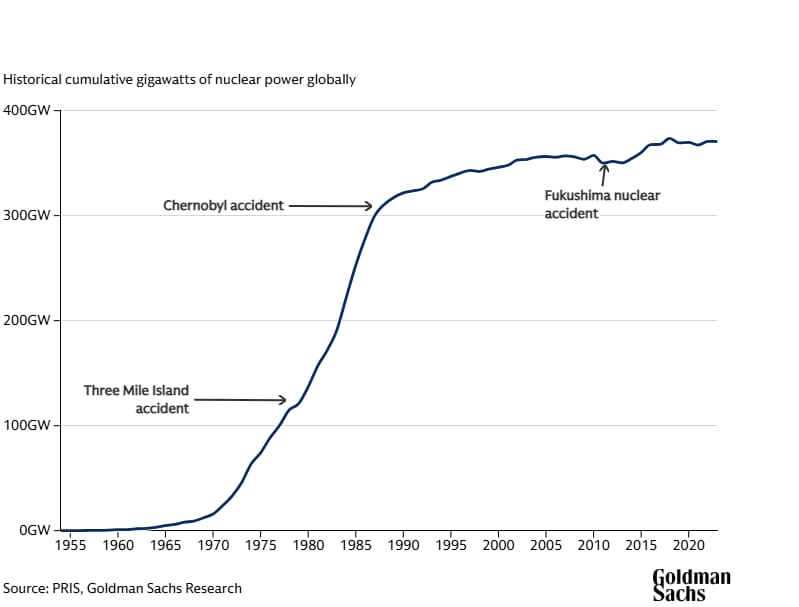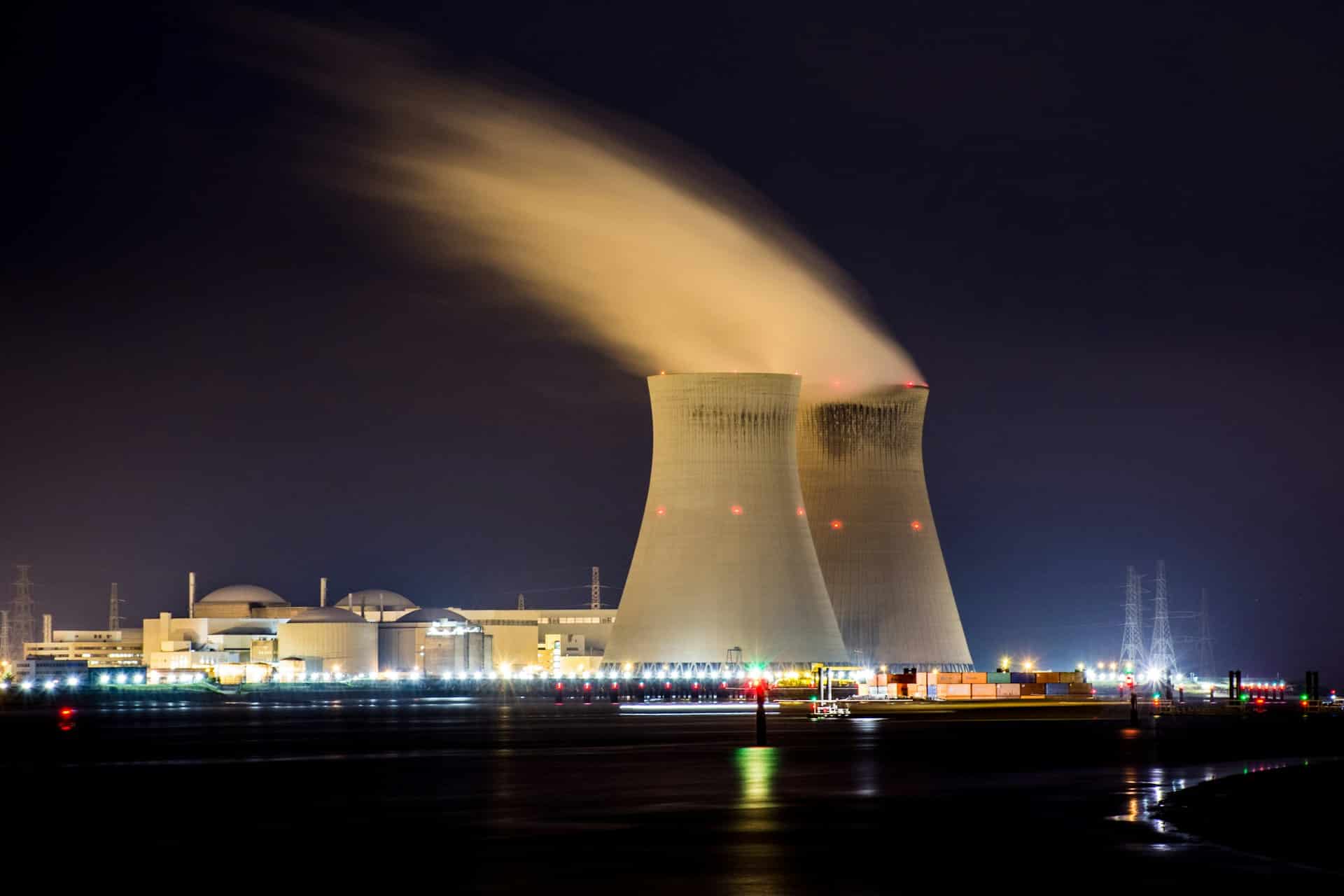While the share of nuclear power in the global energy mix has been stagnant for years, this trend may not last for long amid a thrust from major governments, including the US, as well as growing electricity demand from power-hungry AI data centers, which are looking for reliable sources of energy.
New York is helping to lead the charge by planning to build the first major new nuclear power plant in the country in 15 years. In this article, we’ll discuss why nuclear power has been stagnant for so long, why it’s making a comeback, and the arguments for and against the sector.
Nuclear Energy Is a Polarizing Topic
While nuclear energy was once seen as an answer to rising global electricity demand, and its share in the global electricity mix peaked at around 17% in the 80s, it has since declined to single digits.
Nuclear power has always been a controversial source of energy, and while its proponents tout it one of the cleanest and most efficient energy sources available, the full equation is not so simple.
Some researchers argue against the “green” element in nuclear energy, pointing to emissions from uranium enrichment and radiation from reactors. Naturally, these factors are still vanishingly small when compared to fossil fuel emissions. The disposal of nuclear waste is another problem area that environmentalists cite to counter the argument for nuclear energy.
Major Global Disasters
Nuclear waste has long been a thorn in the side of nuclear advocates, but the potential for severe disaster has often been its biggest problem. The safety of nuclear plants has always been a concern. It’s no surprise that their share in the global electricity mix started tapering off after the 1986 Chernobyl disaster. The Fukushima disaster, which was caused by an earthquake, dampened sentiments further as countries got wary of adding more capacity, fearing accidents, even though modern reactors are believed to be drastically safer.

In the US, nuclear energy has been a particularly polarizing topic since the Three Mile Island accident in 1979. Only 5 new commercial reactors have come online in the country since 1991, which haven’t been able to fill the void from the retiring plants, which has meant that the share of nuclear power in the overall mix has come down.
Global Focus on Nuclear Energy
Nuclear energy and energy in general has been a partisan issue in the US for many years. Democrats have generally been much more supportive of renewable energy, while Republicans triple-down on fossil fuels despite the immense evidence indicating their role in severe climate change. However, many democrats have long been critical of nuclear energy, favoring wind, solar, and hydropower.
President Trump signed executive orders to spur the pace of nuclear energy generation in the country through expedited approvals and set an ambitious goal of expanding the country’s nuclear energy capacity fourfold to 500 Gigawatts by 2050, mostly to fuel incredibly power-hungry AI data centers.
The US is not alone in pivoting towards nuclear energy, and the UK is also constructing the Hinkley Point C nuclear project, which is the first such project in 3 decades. India is also exploring adding more reactors to meet its rising energy needs, even as the progress is slow despite the country signing a civil nuclear deal with the US two decades ago.
China is also planning to build 150 reactors over the next 15 years, and the country’s 14th Five-Year-Plan talks about 200 GW of nuclear power by 2035. The country seems to be progressing well on the set milestones, and according to a Goldman Sachs report, of the 61 nuclear reactors under construction globally, roughly half are located in China.
There is broad-based support for nuclear energy, barring a few exceptions, and 31 countries pledged to triple the world’s global nuclear generation by 2050 at the COP29 climate summit in November 2024.
Nuclear energy looks set for a “renaissance,” and Goldman Sachs expects the share to rise to 12% by 2040 as compared to the 9% that it currently stands at.
What’s Driving the Shift Towards Nuclear Energy?
Investment in nuclear power grew at a CAGR of 14% between 2020 and 2024, which was preceded by flat spending growth in the previous five years. “This has come on the heels of improving policy support globally, underscored by the growing demand for power and less emission-intensive alternatives in a world that is retiring coal plants at a rate much faster than it is building new ones,” Goldman Sachs Research analysts Brian Lee and Carly Davenport wrote in their report.
AI is also driving up demand for nuclear energy. As energy demand spikes amid the AI pivot, tech giants are rushing to secure electricity supplies for their data centers. Earlier this month, Meta Platforms signed a 20-year deal with Constellation Energy, and beginning in 2027, it will purchase about 1.1 gigawatts of nuclear power from the company’s Clinton Clean Energy Center in Illinois. The plant was in danger of premature closure, and the deal with the Facebook parent came in as a lifeline.
Google has also inked deals to secure nuclear power for its AI data centers.
The above video explains the various factors that are helping nuclear energy make a comeback.
Tech Giants Rush to Secure Power for Their Data Centers
The Three Mile Island plant is also set to reopen in 2028 after Constellation Energy signed a power purchase agreement with Microsoft. Amazon is betting on nuclear power to satiate the energy demand of its data centers, and last year, the company signed an agreement to co-locate a data center facility near Talen Energy’s nuclear facility in Pennsylvania. However, the Federal Energy Regulatory Commission has rejected the interconnection request between the two companies.
Amazon also announced the construction of several new Small Modular Reactors (SMRs), which have a smaller footprint and can be built much faster than traditional reactors.
Amazon is going nuclear. They have signed three agreements, all involving SMR's. Involved are Dominion Energy in Virginia, Energy Northwest in Washington State, and Maryland-based X-energy who will develop both new SMR's and fuel. pic.twitter.com/ovfEK7r7L0
— Andrew Curran (@AndrewCurran_) October 16, 2024
These SMRs could help drive the adoption of nuclear energy, and Goldman Sachs estimates that the levelized cost of electricity for the average SMR could be less than $100/megawatt-hour, which is considerably lower than the $125/MWh for traditional reactors.
Nuclear Energy Helps Reduce Reliance on China and Fossil Fuel Imports
One of the reasons countries are pivoting towards nuclear energy is that it helps them reduce their reliance on imports. Germany is a particular case in point. The country phased out nuclear power in 2023 and was found wanting amid the Russia-Ukraine war, which negatively impacted natural gas flows to Europe.
In the solar energy landscape, China controls the lion’s share of the supply chain. Countries globally are getting wary of over-reliance on China, especially in critical industries. The fears are not unfounded, as the country put restrictions on exports of rare earths amid trade tensions with the US. The exports were not resumed until US President Donald Trump called his Chinese counterpart to ease tensions.
Overall, as global energy needs rise, nuclear power is emerging as a credible source that can ensure reliability and help keep costs low and predictable at a time when global fossil fuel prices have whipsawed amid the tensions in the Middle East and the Russia-Ukraine war.
